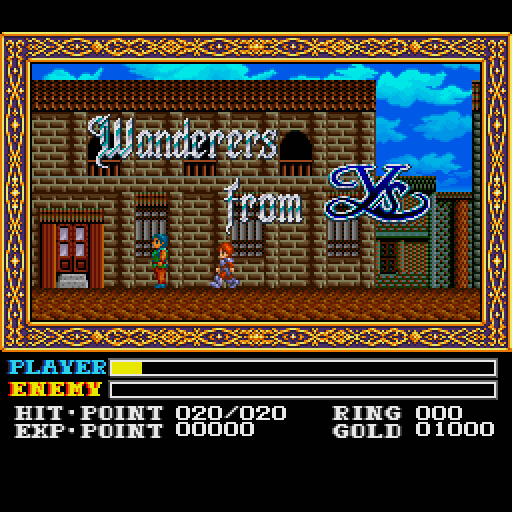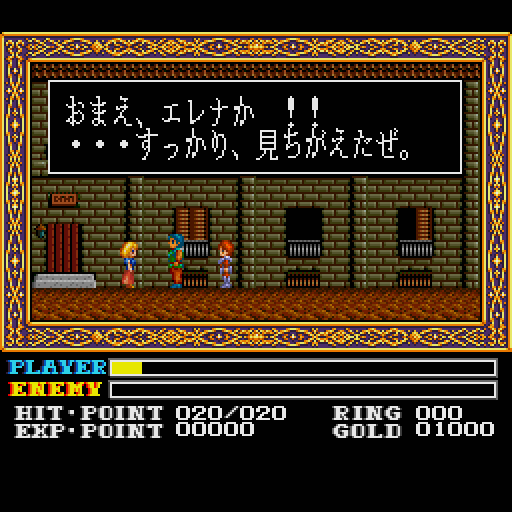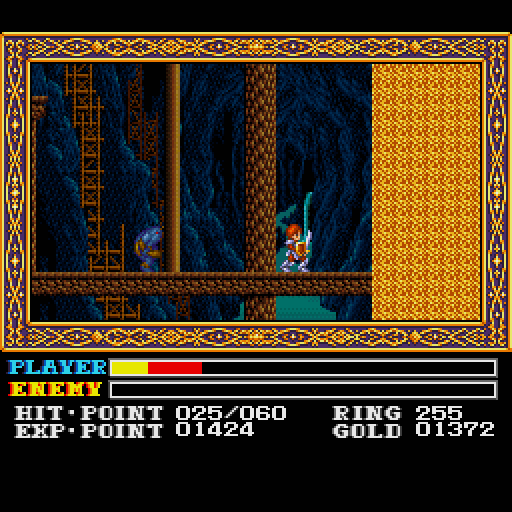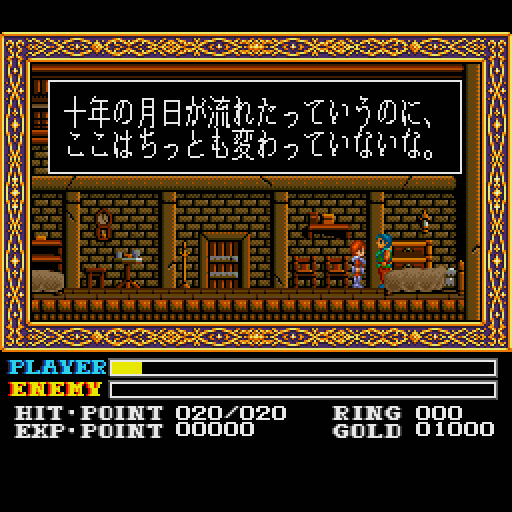
Hi! On a recent whim, I decided to act on an idea that had been percolating in the back of my mind for a while: "you know, I've finished Ys Book I & II, something few others can claim in this day and age, and it led to some rewarding discoveries; wouldn't it be interesting if I played the entire original Ys series, up to the point where it got reborn into an evidently rather standard, distressingly-competent anime action RPG series?" (I think that point is VI, right? Judging from individual release dates, it seems to be the rebirth of the series after a period where it had lain fallow, though there's another gap between VI and VII that suggests the actual start of the modern series may have been one volume later.) I had problems with Book I & II - like, big problems; like, problems that are never, ever brought up in modern conversations considering the esteem in which those titles are held and the infrequency with which they're actually played - but Ys, foundational Ys, is so formative, yet so little-explored, that I think it'd be instructive and archaeological, at the very least. Even when Ys missteps, it does so in ways that are either illuminating as to the challenges of the day or that are entertainingly bizarre.
(Well, entertaining in hindsight. It's not entertaining to run around half the map on increasingly shaggy-dog excuses because the game lost its homework and is trying to stall a suitable amount of time for the finale, but it makes for a good story after the fact.)

With all that in mind, I dove last week into the X68000 version of Wanderers from Ys. You may wonder why I chose such a relatively-obscure platform, and the answer is: Kimimi linked to the soundtrack, and it had absolutely sick music. Before this, I was actually considering playing the Genesis port - I was rooting around for an mp3 of Adol's theme a while back and discovered Sega had a killer version - but upon reflection, music aside, the X68000 seemed a better followup to my TG-16 I & II playthrough. Ys III released on one of the major console platforms runs the risk of being too...refined? Refined and like a grown-up game. As with Book I & II on the TurboGrafx, I'm looking for something more playable than PC-88 beep-boop slideshows, yes, but retaining the essence of the intriguing design decisions of the very first release.

Plus: this version looks very nice. It's bright and colorful in that friendly, dumb-dog Ys way. Right after the adventure proper had gotten underway, and I found Adol standing on the suspension bridge at the quarry with the brilliant blue sky and wisps of clouds behind him, the dauntless chords of "The Boy Who Had Wings," one of the great pieces of video game music, playing - it was just great, the real start you'd want to your adventure.

Given the persnicketiness of getting Mirrors to run on PC-98 emulation (which proved a big stopping point for me until Nebulous Translations came to the rescue with a complete package with all needed downloadables and instructions), I was preparing myself for a world of pain in emulating the X68000. I have to hand it to the developers of the XM6 Pro-68k emulator, though: it is as painless as painless could be for such a platform. You boot the emulator, load Disk 1 into Floppy Drive #0 and Disk 2 into Floppy Drive #1, and you're playing that sucker. I was dreading the task of getting a gamepad working, but all I had to do was plug in an Xbox 360 controller, and Adol was jumping and slashing - the buttons were mapped instantly. I discovered I had to use the keyboard to access the [I]nventory and [S]tatus screens, but this was an utterly negligible sacrifice for practical plug-and-play simplicity of use. This was an excellent emulator experience, and kudos to them.

That user-friendliness and intuitiveness does not extend into the game itself, mind you. After my quest's auspicious start, I ventured into the quarry...and immediately got one-shotted by the very first little bug that touched me. See, just because Adol's sprite had changed to show him equipped with sword and shield after he left the blacksmith in town did not mean he was actually equipped with sword and shield (and armor). While having to equip items is in line with the original Ys, yes, the misdirection of the sprite art, while a minor inconvenience, is still an eye-roller.
So I equipped everything, but this didn't really solve matters. I wasn't getting one-shotted, no, but I was getting bodied, my full health bar near-completely drained in a split second. I was wondering why a creepy-crawly spider, the literal very first enemy, was still almost killing me even as fully-equipped as I could be at the start of the game, and then I realized: Ys III doesn't have i-frames. Zelda did in 1986.
Oh, yes. This is the old Ys I know, the series whose legendary design prowess gave us bump combat.

Ys III's combat philosophy seems to be: you are glass until you grind up to the specified level for the given area, whereupon you are indestructible and will one-shot everything (as I did once I hit Level 3 in the quarry). The game uses a wholly-new-for-the-series side-scrolling presentation inspired by Zelda II, but victory and defeat are still as binary in the Ys universe as they are with bump combat. For example: when I initially encountered the first boss, he would kill me with one hit. He had patterns to learn, and I eventually got to the point where I could survive a good long while, but my skill was in the end irrelevant, as getting hit ultimately proved unavoidable with the number of projectiles he unleashes as his health bar drains, and everything one-shotted me. Had I been allowed to tank even one more hit, it could have been a tough-but-fair battle. Instead of observing an enemy's behavior and employing deft dodging and tactics, though, the answer was just: grind until you render the fight trivial. One more level and an armor upgrade, and I went from instant defeat to killing the boss in literally under a second. It's another one of those utterly-bizarre, anachronistic Ys design decisions: the devs put in learnable patterns, but they didn't go so far as to make mastery of those patterns matter.

Then I progressed to the second area, a fire temple, and not only was Adol as fragile as he was at the start of the first area, but the requisite grinding proved quite perilous, as the enemies were launching screaming fireballs at me from offscreen. As dodging proved near-impossible, the only reliable way to avoid getting creamed was to...slither along on Adol's stomach, crawling under the fireballs, until my foes were in sword's range. I mean, kudos for allowing an ARPG hero to crawl in the first place, since you can usually only duck while stationary, but - I'm storming lost ruins, flames racing around me, facing down deadly pyromancers, and...I have to inch along everywhere on my belly? Oh, Ys.

I haven't said much about the story. I've mentioned that I did play Ys III way back when, on a cartridge I got from Blockbuster's clearance bin, and while I don't remember much, I do recall the simple outlines of the simple tale: Adol's friend Dogi visits home; a brother of one of Dogi's old friends is acting weird; said brother is helping the king he serves resurrect a dark god or demon or other manner of final boss. There is something delightfully quotidian about Adol's friend Dogi wanting to show him his old hometown; Dogi running into people he used to know and them either noting how he's grown or (realistically) not having much time for him, too caught up in their own daily routines; Adol and Dogi checking into the inn; Adol noting how nice the room is and Dogi talking about how he used to work there, etc. I recall the brother and Adol are caught in a cave-in just to give them a chance to talk and Adol to ask "Hey, what's your big attitude problem, anyhow?", and I know Ys III devotes a gameplay segment to Adol and Dogi getting ready to leave in the morning after the adventure is concluded, a realistic touch I haven't seen elsewhere. The ins and outs of Adol & Dogi traveling and interacting and Dogi catching up with people and trying to iron out problems in Dogi's hometown take up more space than the grand quest stuff, and while this seems like a case of misdirected focus (the SNES version added an Ys I-type sequence where a fortuneteller foresees world-shattering disaster), it's oddly appropriate in its homeyness. It's a small story so far as RPGs go, but the game makes it work to an extent by telling it on a suitably small scale, one that pays attention to comfortably, relatably human interactions.

Now, you may wonder why I'm reporting on Ys III at the three-hour mark instead of upon its completion. Well, friends, let me tell you. At the end of the second ruins section, where disgruntled brother drops an eavesdropping Adol into a fiery pit, I came upon a giant chamber where boss music was playing but no boss was to be found. I wandered around the chamber a bit, confused, then headed back out to explore the rest of the fire pit, thinking I had missed something in my pre-grinding clamor. I did encounter a giant lava wall that prompted a warning upon approach; thinking that maybe finding the boss room before the obstacle defeating the boss was clearly meant to unlock screwed up some flag, particularly given the typical caliber of design prowess on display, I loaded an earlier save and took care to visit the chambers in what I thought was the right order. Still no dice, and no boss.
A bit of searching revealed another unfortunate soul - the aforementioned Kimimi herself, in fact - who had encountered the exact same problem a dozen years ago. The lone respondent, whose identity had been deleted in the intervening decade, claimed that it was a "bug" that happened "sometimes," whose origins they'd tried to trace "for hours" to no avail: "Once it happens, you'll have to start the game all over, I'm afraid."
So, absent further information or way to proceed, start the game all over I did - or rather, I attempted. Just in case the "bug" was the result of copy protection, I switched from the files in the huge X68K compilation I'd downloaded from archive.org to some I'd gotten previously off a ROMs depository. So I restarted, and I ground back up to Level 3, whereupon I went toward the first objective, and HA HA HA HA HA:

The wall, it is universally-agreed, is copy protection - a sign that the second set of files I had was not fully cracked. Further searching prompted by this new aggravation revealed speculation that the disappearing boss might be copy-protection as well. I lack the expertise to parse it fully; perhaps you'll fare better. (I can say that .dim vs. .xdf is not the key, as I was using the .dim files and still ran into problems.) In any case, my only paths emulationwise are to a) put another 2-3 hours into the archive.org copy to see if the fire boss refuses to show up again, or b) go around and download different copies from different sites and put time into them - which I doubt will bear fruit, as I imagine all these ROM depositories get their files from one another.

Now, there is an option, theoretically, to play the X68000 version legit via Project EGG, a Japanese subscription service for retro PC games. I say "theoretically" because the service, let us say, presents a number of hurdles. First, there's the issue of whether I'll be able even to pay with an overseas credit card, a habitual problem when dealing with online services based in Japan. Project EGG has an English-language page, but it hasn't been updated since the heady days of Windows 7. Second, even if I am eventually permitted to give them money, there's the question of how many amenities that are taken as a given in modern emulation will be available on Project EGG's service. Are there quicksaves? Is there screenshotting? Can I play the game fullscreen (integer scaling only, thank you)? Will I be able to use a gamepad? (The last is make-or-break for me. Trying to play an action game with a numpad, regardless of the original configuration, is not at all a fair test of its playability.) A look at their application's operating manual says "yes" to all four, which comes as an outright shock, but who knows how well it's all implemented. Not anyone who speaks English, evidently, since there's next to no info on using Project EGG on the English-language web!
Oh, did I mentioned that you have to pay both a monthly subscription fee and an individual purchase price per game? And we wonder why Steam has a stranglehold on the PC market.
Despite all this, attempting to crack Project EGG seems like a more promising route than Warez Warehouse Roulette, so I suppose the other half of this post is sitting on the other end of a 500-yen subscription fee. Failing that, it's back to the archive.org files one more time before sadly writing off the X68000 version for now and falling back on the Genesis version as a stopgap. Music and potential nonrepresentative professionalism aside, I actually kind of don't want to futz with the Sega version. Looking at it, it's too brown, the colors are washed out, the stupid fire-mouth enemies are replaced by the entirely *wrong* stupid fire-mouth enemies - it's wrong, it's all wrong! I want my little jewel-box PC presentation. So it's off to Project EGG, which I suppose is an expedition worthy of a report back in itself. Let's hope it doesn't end up like Skeb.

A game-related note before we go: Despite Dogi's prominence here and later in the Ys series, I cannot recall his role in the first two games. There was the scholar shown with the pendant in the opening, Luka or Luta Gemma, and there was the head of the thieves, and the guy who tried to rescue his girlfriend who was taken to the belltower in II, and the infamous Keith. That's it for notable male NPCs in Dogi's age range I remember. He wasn't the thief, was he? Seems like that would have come up more often subsequently. Someone busted down a wall by hand at some point, right? That seems like Dogi territory. I know Ys didn't set out to be one of gaming's longest-running series and is by necessity making things up as it goes along, but it's interesting - not "ha ha" interesting; just "it's weird how things go sometimes" interesting - that such an important character is in his first appearance completely unremarkable.

